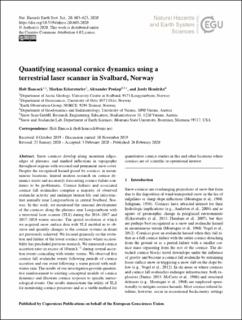| dc.contributor.author | Hancock, Holt John | |
| dc.contributor.author | Eckerstorfer, Markus | |
| dc.contributor.author | Prokop, Alexander | |
| dc.contributor.author | Hendrikx, Jordy | |
| dc.date.accessioned | 2020-11-20T11:08:16Z | |
| dc.date.available | 2020-11-20T11:08:16Z | |
| dc.date.created | 2020-02-10T13:27:34Z | |
| dc.date.issued | 2020 | |
| dc.identifier.citation | Natural hazards and earth system sciences. 2020, 20 (2), 603-623. | en_US |
| dc.identifier.issn | 1561-8633 | |
| dc.identifier.uri | https://hdl.handle.net/11250/2688878 | |
| dc.description.abstract | Snow cornices develop along mountain ridges, edges of plateaus, and marked inflections in topography throughout regions with seasonal and permanent snow cover. Despite the recognized hazard posed by cornices in mountainous locations, limited modern research on cornice dynamics exists and accurately forecasting cornice failure continues to be problematic. Cornice failures and associated cornice fall avalanches comprise a majority of observed avalanche activity and endanger human life and infrastructure annually near Longyearbyen in central Svalbard, Norway. In this work, we monitored the seasonal development of the cornices along the plateaus near Longyearbyen with a terrestrial laser scanner (TLS) during the 2016–2017 and 2017–2018 winter seasons. The spatial resolution at which we acquired snow surface data with TLS enabled us to observe and quantify changes to the cornice systems in detail not previously achieved. We focused primarily on the evolution and failure of the lower cornice surfaces where accessibility has precluded previous research. We measured cornice accretion rates in excess of 10 mm h−1 during several accretion events coinciding with winter storms. We observed five cornice fall avalanche events following periods of cornice accretion and one event following a warm period with midwinter rain. The results of our investigation provide quantitative reinforcement to existing conceptual models of cornice dynamics and illustrate cornice response to specific meteorological events. Our results demonstrate the utility of TLS for monitoring cornice processes and as a viable method for quantitative cornice studies in this and other locations where cornices are of scientific or operational interest. | |
| dc.language.iso | eng | en_US |
| dc.rights | CC BY 4.0 | |
| dc.rights.uri | http://creativecommons.org/licenses/by/4.0/ | |
| dc.title | Quantifying seasonal cornice dynamics using a terrestrial laser scanner in Svalbard, Norway | en_US |
| dc.type | Peer reviewed | en_US |
| dc.type | Journal article | en_US |
| dc.rights.holder | © 2020, Authors | |
| dc.description.version | publishedVersion | |
| cristin.ispublished | true | |
| cristin.fulltext | original | |
| cristin.qualitycode | 1 | |
| dc.identifier.doi | 10.5194/nhess-20-603-2020 | |
| dc.identifier.cristin | 1792648 | |
| dc.source.journal | Natural hazards and earth system sciences | en_US |
| dc.source.volume | 20 | en_US |
| dc.source.issue | 2 | en_US |
| dc.source.pagenumber | 603-623 | en_US |

